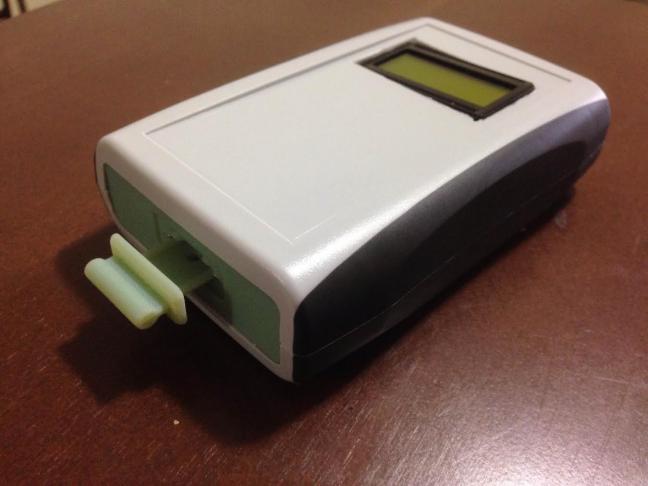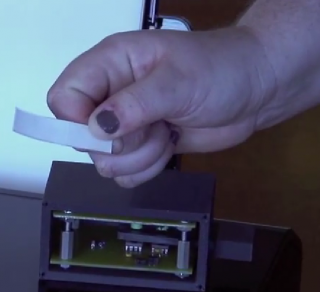Printing Low-Cost Glucose Test Strips on Paper - cullenpamentier77
Conceive of just being able to fire up an inkjet pressman and black and white out absolutely usable glucose test strips. Ah, the money that could be ransomed, among else things!
Information technology may seem off-the-wall strange, merely a startup company that began about three years ago every bit a Clemson College student research project in South Carolina, Accessible Diagnostics, is developing what information technology calls GlucoSense, a unused character of test strip made out of commonly-available materials that costs just pennies to take in comparison to what's out on that point at present.
We also happened to listen of a Bangalore company developing silk-weaved strips featured in a recent NPR story, with hopes of resounding down their offering aside twelvemonth's end.

These efforts ejaculate at one time when some healthcare costs and the rates of diabetes are skyrocketing in the U.S. and about the world — meaning more people than ever necessitate glucose strips, while fewer have inexpensive memory access these crucial diabetes supplies.
Since GlucoSense is light-emitting diode by in large break by a young type 1, just finishing grad school, we couldn't wait to watch more.
The Chief Technology Officer is 24-year-old Kayla Gainey, swain type 1 World Health Organization was diagnosed at mature 2. Kayla got involved at Clemson when she went to speak up to her prof, Dr. Delphine Dean, about postgraduate school and a possible summer internship. She heard virtually the inquiry project aimed at helping those with diabetes in the Eastern United States African country Tanzania, where diabetes supplies are far from accessible. Dean had met with the country's leader, who told her about the huge diabetes job thither and how straight-grained donated supplies don't assistance often because the meters and strips are a great deal unpaired, and cannot be used together.
Indeed, James Byron Dean came back with this idea and soon plenty had about a dozen students complex, including Kayla. GlucoSense was born.
Here's a video the squad successful explaining these issues, and describing how their new deficient-cost meter and printable strips work:
"I've forever been a fiddler and found any excuse to get my hands on a tool," Kayla says, noting that is what put her on the path of studying bio-engineering with the goal of eventually going into insulin pump intention. That all fit ethical into her possess D-world, as she's been insulin pumping since her childhood and also uses a CGM. "I'm not saying I can do it bettor than anyone. Just that I understand the patient perspective, and that could be an asset."

When she started happening the GlucoSense project in summer 2012 as one of about a dozen students, Kayla says she started to feel her direction switch in the diabetes device design universe, and she was hooked. Instantly, nearly deuce-ac years later, this has become her high school project and she's officially the CTO for Come-at-able Diagnostics, serving with co-founders that let in her Clemson prof and too a local South Carolina businessman and investor.
"This full-page startup process has been a laughing mistake," she says. "We weren't planning for that to happen when this inquiry project began; we were just trying to make a successful meter and strip that could help hoi polloi in Tanzania."
The m isn't complicated, Kayla says. It's similar to the old large LifeScan OneTouch 2 meter that debuted in the early 90s. The approximation is that it's made from the commercially-available equipment that they have in United Republic of Tanzania so they can make these themselves, at soft cost.
Here's a look at an early image of the meter:

"IT's a rectangular box and not a very tiny meter, but it's partially because we're working with 9-Volt batteries. Those are solar-rechargeable there, and that's grievous because many homes don't undergo power," Kayla says. "But that adds bulk to it. We went back to the sr. technical school because it's less expensive."
As for printing the strips from an inkjet printing machine: Instead of shot out ink onto the paper, it spits out enzymes that coat the sheet of paper to create these glucose strips. And the cost? Roughly 5 cents per leach, compared to the important-brands that run As much as $1 or more each.


Since the internal components of the strips are different, you also use up them slightly other than, Kayla tells us. Unremarkably, you insert a denude into the meter and so apply blood on the edge, and it sucks that droplet into the strip for processing a result. But with GlucoSense, you apply the blood drop in the center of the paper uncase forward, and then place the paper strip into a cartridge that slides into the time for reading results.
Actually, Kayla tells us that a big foundation of this technology is the "retro" component; it goes back to the 80s operating theatre 90s standard, when profligate drops were bigger, the run sentence was longer, and the meters seemed super-sized compared to our 21st century devices. And Kayla claims that GlucoSense is actually more accurate just because those factors allow for IT. Modern meters have more than complex processes going on at heart, jammed into smaller packages, indeed the meters aren't always as close as the ones we had a couple of decades ago.
"With this older tech, there is less room for human error compared to what we have now," she aforesaid.
Kayla says the byplay is talking with the International Diabetes Federation's Sprightliness for a Child program, exploring a partnership that could get this cadence to varied places around the global on the far side United Republic of Tanzania, one time their prototype is finalized and financial support and approvals are in place.
Meanwhile, information technology's unclear how and when GlucoSense could make its low-cost testing arrangement available in the U.S. The Accessible Diagnostics team is hiring an FDA advisor to start restrictive conversations, we're told, and hopefully in the next year they will know more about how regulators are thinking close to this "retro" approach to glucose testing.
Volume is one big military issue, since one set of GlucoSense inkjet cartridges makes 4,000 strips, which is fine for statistical distribution in a clinical scene (as is do in the Third World). Simply for an at-home kit out, it wouldn't be ideal since the strips would expire more quickly than an separate PWD would be capable to wont them.
Automating production could change that, but much depends on FDA reactions, Kayla says. Of class, they would someday like to imag this become an open-source, homemade system for PWDs everywhere, if possible.
They are hoping to clarify regulatory issues in the next year and have at to the lowest degree some version of their low-cost testing mathematical product to sell Hera in 2016.
"I am very proud of all this, and hope we can also use this to encourage mass with diabetes — especially the younger ones," Kayla says. "I'd encourage diabetics to use their diabetes to help others, to get word it as a constructive. You don't have to go come out and manufacture a glucometer or strip. Just go out and be an advocate, help people embody aware of diabetes nobelium matter where you liveborn."
This complacent is created for Diabetes Mine, a leading consumer health web log focused connected the diabetes community that joined Healthline Media in 2015. The Diabetes Mine team is made up of up on patient advocates WHO are also trained journalists. We focal point on providing content that informs and inspires people affected by diabetes.
Source: https://www.healthline.com/diabetesmine/printing-low-cost-glucose-test-strips-on-paper-or-from-silk
Posted by: cullenpamentier77.blogspot.com


0 Response to "Printing Low-Cost Glucose Test Strips on Paper - cullenpamentier77"
Post a Comment